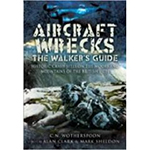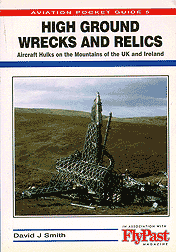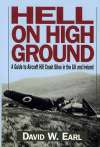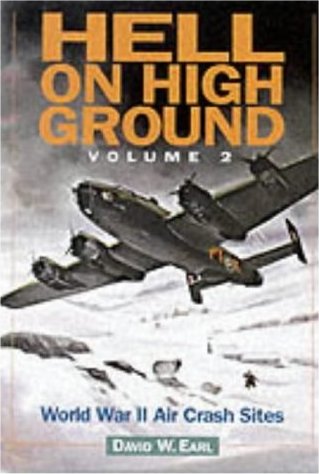Hillwalkers often have absolutely no idea that these sites exist. Resources to find out more about them are few and far between and not particularly detailed. There are really only three books available with good information:
Review of HGWR in 'The Angry Corrie' hillwalking fanzine:
http://bubl.ac.uk/org/tacit/TAC/tac33/crashhig.htm
HGWR is now hard to get a copy of but has the most complete listing of sites, along with map grid references; HHG and HHG2 have less sites but go into a lot more detail about the history and background of each crash.
 In July 2009, a new book was published offering up-to-date detailed information about wreck sites in Scotland (as well as the rest of the British Isles):
In July 2009, a new book was published offering up-to-date detailed information about wreck sites in Scotland (as well as the rest of the British Isles):
Whilst these books are informative and well-researched, they do not cover Scotland well (with the exception of AWWG), they do not have very good photographs of the wreck sites, and they do not have very good up-to-date information about the location and physical state of the sites (again, with the exception of AWWG). They also, in my opinion, are understandably excellent at providing the historical perspective of these sites, but do not cover them from the perspective of someone who is primarily a hillwalker, and is interested in these sites as they exist in the context of the Scottish mountain landscape (despite its subtitle, AWWG is not really a hillwalking guide). HGWR also attempts to be authoritative about listing as many crash sites as possible, but in doing so lists sites where no trace of the crash remains, and thus are only of interest to historians and not hillwalkers.
Good information about wreck locations is important, because not all of the sites are easy to find, and often the remains of the crash are dispersed in several different locations, many hundreds of metres apart. A single six-figure grid reference, of the sort given in HGWR refers to a square measuring 100 metres on a side, so finding an exact crash site location on a mountain using this grid reference with a map can be a difficult task, particularly if the landscape has small ravines or boulder fields that wreckage may have fallen into. The grid references in HGWR are in my experience not even accurate to 100m.
There are also a few websites with good information about Scottish crash sites, and some photographs:
- Tommy, Flash 'n' Dogbreath's Aircraft Crash Sites of Scotland:
http://www.scotcrash.homecall.co.uk/ [TFDACSS] - Air Crash Sites Scotland: large site full of details and photographs:
http://www.aircrashsites-scotland.co.uk [ACSS] (new site May 10) - World War II Aviation Crash Sites in Scotland:
http://www.archieraf.co.uk/scs/index.html [WW2ACSS] (new site Feb 07) - Peak District Air Accident Research web site: good information about some little-known Scottish wreck sites:
http://www.peakdistrictaircrashes.co.uk/scotland.htm [PDAAR] - [site no longer active] Air Crash Investigation & Archaeology: some good information and pictures of little-known sites in the Scottish Borders:
http://www.acia.co.uk [ACIA] - Aircraft Wrecks in the UK & Ireland (David W. Earl, HHG author):
http://members.lycos.co.uk/daveswrecks/ [AWUK&I]
http://www.webspawner.com/users/daveswrecks/ (new site Oct 09) - www.yorkshire-aircraft.co.uk: information about several Scottish crash sites:
http://www.yorkshire-aircraft.co.uk/aircraft/table3.html [WYACU] (new site May 09) - Some good photographs of various Scottish sites going back to the 80s on this personal website:
http://www.gairney.plus.com/Aircraft/Photographs/aircraft_Wrecks/aircraft-HGW.htm [NBSAB] - Flickr group 'Military Airplane Crash Sites' (mostly sites in England and Wales, but a few from Scotland):
http://www.flickr.com/groups/aircrashwrecks/ [MACS(Flickr)] - Although this website is exclusively about wreck sites in Norway (many of which are in the mountains) I had to include it here as well as it is so impressive, and I have been walking in the mountains of Norway a few times; perhaps in the future I may visit some of the wreckage sites it covers:
Flyvrak (World War II Aircraft wrecksites in Norway):
http://ktsorens.tihlde.org/flyvrak/ - What to do while Highland Dancing [WTDHD] (new site Sep 15)
There is also some academic research being carried out on military aircraft wreck sites in remote areas of Scotland by the Centre for Battlefield Archaeology at the University of Glasgow. Terence Christian from the Centre is currently writing his PhD thesis with the title 'Operations Analysis of Second World War Squadrons in Scotland Including a New Methodology for Aircraft Wreck Excavation'. A BBC news article from April 2011 about Terence's study of various sites can be seen here, and a BBC news article from October 2011 about Terence's study of the B-17 Flying Fortress crash site on Skye can be seen here.



